Petroleum
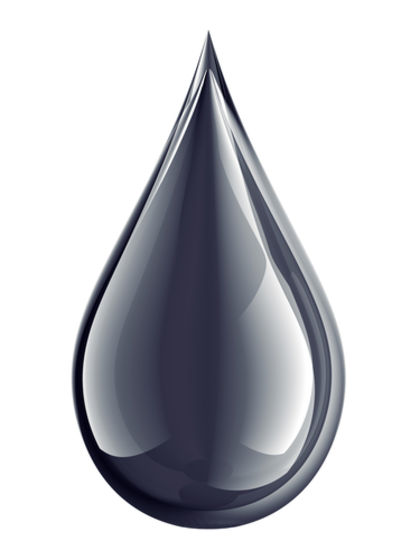
Petroleum is a naturally occurring liquid oil normally found in deposits beneath the surface of the earth. It is a type of oil composed of rock minerals, making it different from other kinds of oils that come from plants and animals (such as vegetable oil, animal fat, or essential oils). The word petroleum comes from the Latin words petra (rock) and oleum (oil), and so literally means rock oil. Despite this, petroleum is an organic compound, formed from the remains of microorganisms living millions of years ago. It is one of the three main fossil fuels, along with coal and natural gas.
Petroleum Economy
Petroleum, like all fossil fuels, primarily consists of a complex mixture of molecules called hydrocarbons (molecules containing both hydrogen and carbon). When it comes out of the ground, it is known as crude oil, and it may have various gases, solids, and trace minerals mixed in with it. Through refinement processes, a variety of consumer products can be made from petroleum. Most of these are fuels: gasoline, jet fuel, diesel fuel, kerosene, and propane are common examples. It is also used to make asphalt and lubricant grease, and it is a raw material for synthetic chemicals. Chemicals and materials derived from petroleum products include plastics, pesticides, fertilizers, paints, solvents, refrigerants, cleaning fluids, detergents, antifreeze, and synthetic fibers.
The modern petroleum industry began in 1859 in Pennsylvania, when a man named Edwin L. Drake constructed the first oil well, a facility for extracting petroleum from natural deposits. Since then, petroleum has become a valuable commodity in industrialized parts of the world, and oil companies actively search for petroleum deposits and build large oilextraction facilities. Several deposits exist in the United States. However, around 1960 oil production in the country began to decline as oil in the deposits was being used up and fewer new deposits were being discovered. Demand for petroleum products continued to increase, and as a result the United States came to rely more and more on oil imported from other countries. In 2001 the amount of petroleum extracted from deposits in the United States was estimated to be only one-third of the amount demanded by U.S. consumers. A similar pattern exists in other industrialized countries, and some, like Japan and Germany, import almost all of the oil they use.
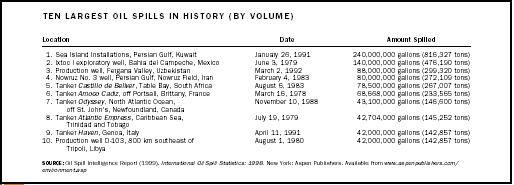
| Location | Date | Amount Spilled |
| SOURCE: Oil Spill Intelligence Report (1999). International Oil Spill Statistics: 1998. New York: Aspen Publishers. Available from www.aspenpublishers.com/environment.asp | ||
| 1. Sea Island Installations, Persian Gulf, Kuwait | January 26, 1991 | 240,000,000 gallons (816,327 tons) |
| 2. Ixtoc I exploratory well, Bahia del Campeche, Mexico | June 3, 1979 | 140,000,000 gallons (476,190 tons) |
| 3. Production well, Fergana Valley, Uzbekistan | March 2, 1992 | 88,000,000 gallons (299,320 tons) |
| 4. Nowruz No. 3 well, Persian Gulf, Nowruz Field, Iran | February 4, 1983 | 80,000,000 gallons (272,109 tons) |
| 5. Tanker Castillo de Bellver , Table Bay, South Africa | August 6, 1983 | 78,500,000 gallons (267,007 tons) |
| 6. Tanker Amoco Cadiz , off Portsall, Brittany, France | March 16, 1978 | 68,668,000 gallons (233,565 tons) |
| 7. Tanker Odyssey , North Atlantic Ocean, off St. John's, Newfoundland, Canada | November 10, 1988 | 43,100,000 gallons (146,600 tons) |
| 8. Tanker Atlantic Empress , Caribbean Sea, Trinidad and Tobago | July 19, 1979 | 42,704,000 gallons (145,252 tons) |
| 9. Tanker Haven , Genoa, Italy | April 11, 1991 | 42,000,000 gallons (142,857 tons) |
| 10. Production well D-103, 800 km southeast of Tripoli, Libya | August 1, 1980 | 42,000,000 gallons (142,857 tons) |
However, on a per capita basis, the consumption in these countries is nowhere near the consumption in the United States.
The United States and Canada are unique in that, on average, an individual in these countries consumes about twice as much petroleum product as do individuals in most other industrialized nations. People in the United States and Canada rely more on personal vehicles for their transportation and tend to drive greater distances, making petroleum their major source of energy. In the United States, about two-thirds of the petroleum consumed is transportation fuel, and two-thirds of that (45% of the total) is gasoline for cars and trucks. About 40 percent of the energy used in the United States every year comes from petroleum.
Foreign Oil Dependence
Political leaders in the United States have long been gravely concerned about the country's growing dependence on foreign oil, which in many ways puts the country at the mercy of foreign governments, some of them hostile to the United States. The greatest production of crude oil in the world is in the Persian Gulf region of the Middle East, where about 65 percent of the world's known petroleum deposits are located. About half of U.S. imports come from members of the Organization of the Petroleum Exporting Countries (OPEC), a group of countries encompassing the Persian Gulf and certain parts of Africa and South America. Events in these often volatile regions can have a huge impact on oil prices in the United States and worldwide, and because of the crucial role oil plays in U.S. society any change in the price can precipitate uncontrollable shifts in the country's economy (see chart "World Oil Price 1970-2000"). The most famous example of this is the Arab Oil Embargo of 1973 to 1974, when U.S. support for Israel in a conflict in the Middle East led to a decision by OPEC to impose steep price increases on the sale of oil to the United States. One response by the U.S. government has been the establishment of the Strategic Petroleum Reserve, an emergency stockpile designed to sustain the country's oil needs for approximately three months in the event of a complete cutoff of imports. There is little doubt, however, that dependence on foreign oil is both a political liability for the United States as well as a risk to national security.
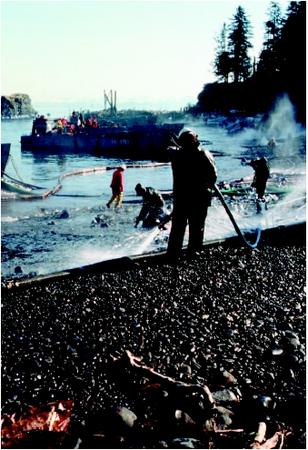
Environmental Pollution
Petroleum-derived contaminants constitute one of the most prevalent sources of environmental degradation in the industrialized world. In large concentrations, the hydrocarbon molecules that make up crude oil and petroleum products are highly toxic to many organisms, including humans. Petroleum also contains trace amounts of sulfur and nitrogen compounds, which are dangerous by themselves and can react with the environment to produce secondary poisonous chemicals. The dominance of petroleum products in the United States and the world economy creates the conditions for distributing large amounts of these toxins into populated areas and ecosystems around the globe.
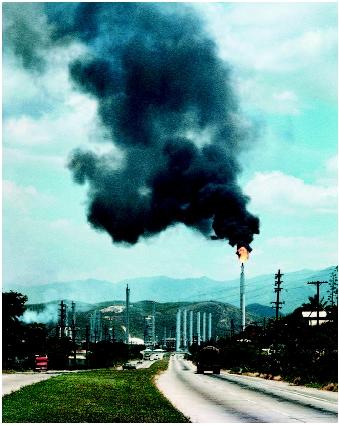
Oil Spills
Perhaps the most visible source of petroleum pollution are the catastrophic oil-tanker spills—like the 1989 Exxon Valdez spill in Prince William Sound, Alaska—that make news headlines and provide disheartening pictures of oilcoated shorelines and dead or oiled birds and sea animals. These spills occur during the transportation of crude oil from exporting to importing nations. Crude oil travels for long distances by either ocean tanker or land pipeline, and both methods are prone to accidents. Oil may also spill at the site where it is extracted, as in the case of a blowout like the Ixtoc I exploratory well in 1979 (see table "Ten Largest Oil Spills in History"). A blowout is one of the major risks of drilling for oil. It occurs when gas trapped inside the deposit is at such a high pressure that oil suddenly erupts out of the drill shaft in a geyser.
Accidents with tankers, pipelines, and oil wells release massive quantities of petroleum into land and marine ecosystems in a concentrated form. The ecological impacts of large spills like these have only been studied for a very
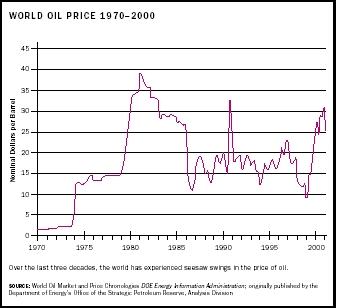
Nonpoint Sources
Spills from tankers, pipelines, and oil wells are examples of point sources of pollution, where the origin of the contaminants is a single identifiable point. They also represent catastrophic releases of a large volume of pollutants in a short period of time. But the majority of pollution from oil is from nonpoint sources, where small amounts coming from many different places over a long period of time add up to large-scale effects. Seventy percent of the oil released by human activity into oceans worldwide is a result of small spills during petroleum consumption. These minor unreported spills can include routine discharges of fuel from commercial vessels or leakage from recreational boats. However, in North America, the majority of the release originates on land. Oil tends to collect in hazardous concentrations in the stream of wastewater coming out of cities and other populated areas. Runoff from asphalt-covered roads and parking lots enters storm drains, streams, and lakes and eventually travels to the ocean, affecting all of the ecosystems through which it passes. As cities grow, more and more people use petroleum products—lubricants, solvents, oil-based paint, and, above all, gasoline—and these are often improperly disposed of down drains and sewage pipes. Industrial plants also produce small, chronic spills that aren't noticed individually, but add up over time and enter waterways.
Taken together, land-based river and urban runoff sources constitute over half of the petroleum pollution introduced to North American coastal waters due to human activity, and 20 percent of the petroleum pollution introduced to ocean waters worldwide. When wastewater from these sources enters the marine environment it is usually by means of an estuary, an area where freshwater from land mixes with seawater. Estuaries are especially critical habitats for a variety of plants and animals, and are among the ecosystems most sensitive to pollutants.
Petroleum-Contaminated Soil
Not all oil released from land sources is quickly washed away to sea, however. Pipeline and oil-well accidents, unregulated industrial waste, and leaking underground storage tanks can all permanently contaminate large areas of soil, making them economically useless as well as dangerous to the health of organisms living in and around them. Removing or treating soil contaminated by petroleum is especially urgent because the hydrocarbons can leach into the underlying groundwater and move into human residential areas. The engineering field of bioremediation has emerged in recent decades as a response to this threat. In bioremediation, bacteria that feed on hydrocarbons and transform them into carbon dioxide can be applied to an affected area. Bioremediation has in many cases made cleaning up petroleum-contaminated sites a profitable real-estate investment for land developers.
Air Pollution
The U.S. Environmental Protection Agency (EPA) designates six criteria pollutants for determining air quality. These are: carbon monoxide (CO), nitrogen oxides (NO and/or NO 2 , usually referred to as NO x ), sulfur dioxide (SO 2 ), ground-level ozone (O 3 ), particulate matter (including things like soot, dust, asbestos fibers, pesticides, and metals), and lead (Pb). Petroleum-fueled vehicles, engines, and industrial processes directly produce the vast majority of CO and NO x in the atmosphere. They are also the principal source of gaseous hydrocarbons (also called volatile organic compounds, or VOCs), which combine with NO x in sunlight to create O 3 . Ozone, while important for blocking ultraviolet rays in the upper atmosphere, is also a key component of urban smog and creates human health problems when present in the lower atmosphere. Sulfur dioxide is a trace component of crude oil, and can cause acid rain when released into the air at oil refineries or petroleum power plants. Particulate matter is directly emitted in vehicle exhaust and can also form from the reaction of exhaust gases with water vapor and sunlight. Finally, leaded gasoline is a huge contributor of lead to the atmosphere, and the use of unleaded gasoline has decreased lead concentrations dramatically. The EPA and the World Bank are working to encourage the phaseout of leaded gasoline worldwide.
Petroleum-fueled transportation and coal-burning power plants are considered the chief causes of global warming. Excess amounts of carbon dioxide, methane, and NO x , among other gases, trap heat in the atmosphere and create the greenhouse effect. Carbon dioxide (CO 2 ) is a main constituent of petroleum fuel exhaust, even though it is not toxic and therefore not classified as a pollutant. About one-third of the CO 2 emitted into the atmosphere every year comes from vehicle exhaust. Methane (NH 3 ), although usually associated with natural gas, is also emitted whenever crude oil is extracted, transported, refined, or stored.
The Future of Petroleum
The world's reliance on petroleum is expected to grow, despite widespread environmental, economic, and political consequences. The U.S. oil extraction industry continues to aggressively search for new oil deposits and lobby the federal government to open up restricted areas to drilling. The Arctic National Wildlife Refuge in Alaska has been on the oil industry agenda for several decades, creating a long-standing environmental controversy. Advances in oil well technology have allowed extraction in the deep ocean beyond the continental shelf, but these have not been enough to reverse the trend of declining production in the United States.
There are many compelling reasons to decrease society's dependence on petroleum for energy, and the most obvious place to begin is in the transportation sector. Energy-efficient engines and hybrid gas/electric cars can help to reduce some of the need for oil, providing higher gas mileage and less demand. A variety of alternative fuels have also been developed, such as ethanol, biodiesel (made from vegetable oil), and hydrogen. Each of these would produce little or no exhaust pollutants or greenhouse gases, and each derives from plentiful renewable resources. The United States is now in fact actively researching hydrogen as a viable alternative to gasoline, and the hydrogen fuel cell as a substitute for the internal combustion engine.
Petroleum is a useful chemical substance for many important purposes. But it is also a nonrenewable resource with a highly toxic composition, and it poses significant problems when used in huge volumes throughout the industrialized world.
SEE ALSO A IR P OLLUTION ; A RCTIC N ATIONAL W ILDLIFE R EFUGE ; C OAL ; D ISASTERS: O IL S PILLS ; E CONOMICS ; E LECTRIC P OWER ; E NERGY ; F OSSIL F UELS ; G LOBAL W ARMING ; O ZONE ; NO x ; R ENEWABLE E NERGY ; S ULFUR D IOXIDE ; U NDERGROUND S TORAGE T ANKS ; V EHICULAR P OLLUTION .
Bibliography
Oil Spill Intelligence Report. (1997). Oil Spills from Vessels (1960–1995): An International Historical Perspective. New York: Aspen Publishers.
Internet Resources
Committee on Oil in the Sea, National Research Council. (2003). Oil in the Sea III: Inputs, Fates, and Effects. Washington, D.C.: The National Academies Press. Available from http://www.nap.edu/catalog/10388.html .
Energy Information Administration. "Official Energy Statistics from the U.S. Government." Available from http://www.eia.doe.gov .
Exxon Valdez Oil Spill Trustee Council. "Restoring the Resources Injured by the Exxon Valdez Oil Spill and Understanding Environmental Change in the Northern Gulf of Alaska." Available from http://www.oilspill.state.ak.us .
National Biodiesel Board. "Need a Fill Up?" Available from http://www.biodiesel.org .
National Ethanol Vehicle Coalition. "National Ethanol Vehicle Coalition and E85." Available from http://www.e85fuel.com .
National Oceanic and Atmospheric Administration. "Office of Response and Restoration, National Ocean Service." Available from http://response.restoration.noaa.gov .
Schlumberger Excellence in Educational Development (SEED) Science Center. "Science Lab: Oil Well Blowout Simulator." Available from http://www.slb.com/seed/en/lab/blowout .
Trench, Cheryl J. (2001). "Oil Market Basics." Washington, D.C.: Energy Information Administration. Available from http://www.eia.doe.gov .
U.S. Department of Energy. "Energy Efficiency and Renewable Energy." Available from http://www.eere.energy.gov .
U.S. Department of Energy. "Fossil.energy.gov: A U.S. Department of Energy Web Site." Available from http://www.fossil.energy.gov .
U.S. Department of Energy. "Fossil Fuels: An Energy Education Website." Available from http://www.fossil.energy.gov/education .
U.S. Environmental Protection Agency. (1995). Profile of the Petroleum Refining Industry. Washington, D.C.: U.S. Government Printing Office. Available from http://www.epa.gov .
U.S. Environmental Protection Agency. (1999). Profile of the Oil and Gas Extraction Industry. Washington, D.C.: U.S. Government Printing Office. Available from http://www.epa.gov .
U.S. Environmental Protection Agency. "Air Quality Where You Live." Available from http://www.epa.gov/air/urbanair/index.html .
U.S. Geological Survey. Available from http://www.usgs.gov .
U.S. Geological Survey. (1997). "Bioremediation: Nature's Way to a Cleaner Environment." Available from http://water.usgs.gov/wid/html/bioremed.html .
Adrian MacDonald
OIL SEEPS
Almost half (45%) of the petroleum entering the marine environment is from natural seeps rather than anthropogenic sources. At seeps, oil and gas bubble out of cracks in the seabed creating special environments in which new organisms grow. These organisms survive through chemosynthesis rather than photosynthesis. They live in total darkness, more than four hundred meters below sea level, but survive by feeding directly off the hydrocarbons present in seeps or by eating carbon compounds resulting from chemosynthetic bacterial degradation of seep oil. Since 1984 oceanographers have discovered chemosynthetic communities of clams, mussels, tubeworms, bacterial mats, and other organisms on the seafloor of the Gulf of Mexico. United States Department of the Interior regulations protect these chemosynthetic communities from damage due to oil and gas drilling activities.